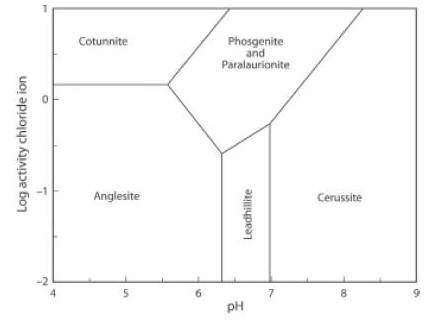Stability
The Activity-pH diagram below was calculated for some lead minerals. Boundaries are calculated for constant activity (roughly equivalent to concentration) of (SO4)2- and constant partial pressure (also roughly equivalent to concentration) of CO2, over a range of values of pH and of Cl1- activity. In this case the concentration of CO2 is appreciably more than the atmospheric value.
Phosgenite is stable in a range of pH from somewhat acid to somewaht alkaline, with a fairly high concentration of Cl- ions (JRS 15.18-23).

The lead mineral formulae are:
cotunnite PbCl2
phosgenite Pb2(CO3)Cl2
cerussite Pb(CO3)
anglesite Pb(SO4)
The Activity-pH diagram below is similar but in this case the concentration of CO2 is not so much above the atmospheric value.
Paralaurionite and phosgenite can co-exist at this CO2 concentration. At higher concentrations phosgenite is the stable mineral, and at lower concentrations paralaurionite is the stable mineral (JRS 15.18-23).

The lead mineral formulae are:
cotunnite PbCl2
phosgenite Pb2(CO3)Cl2
paralaurionite PbCl(OH)
cerussite Pb(CO3)
anglesite Pb(SO4)
leadhillite Pb4(CO3)2(OH)2
Back to Minerals